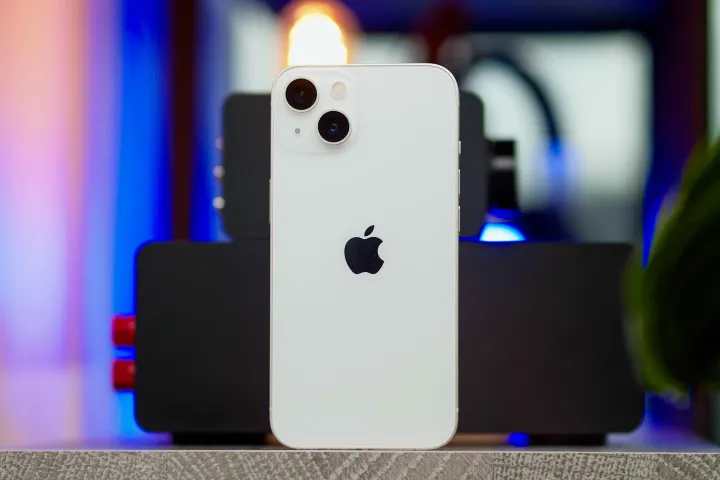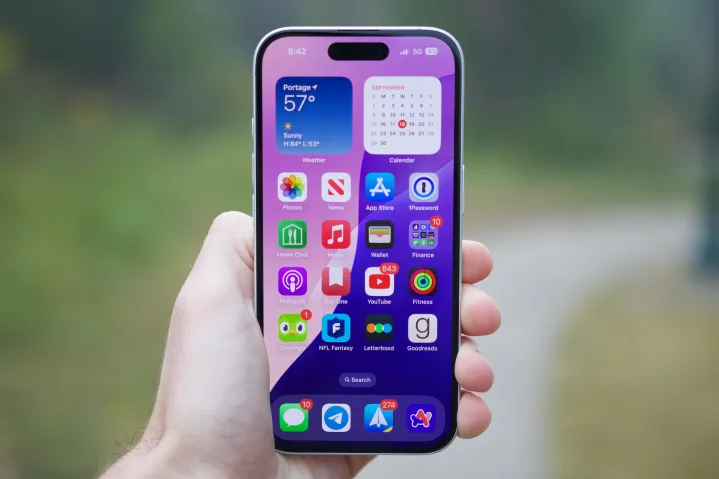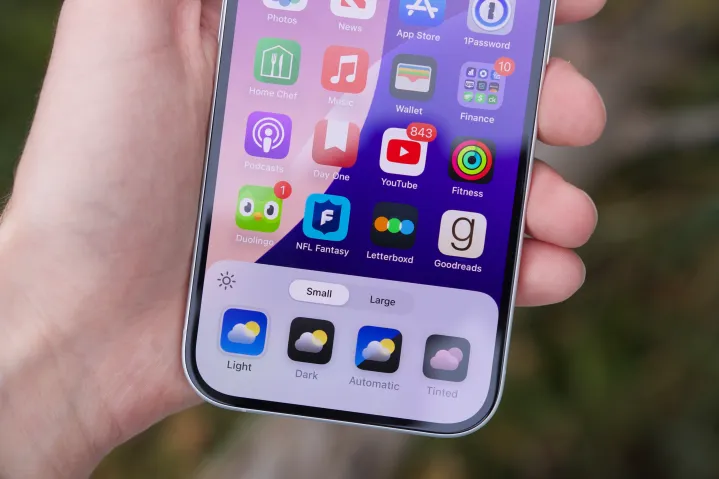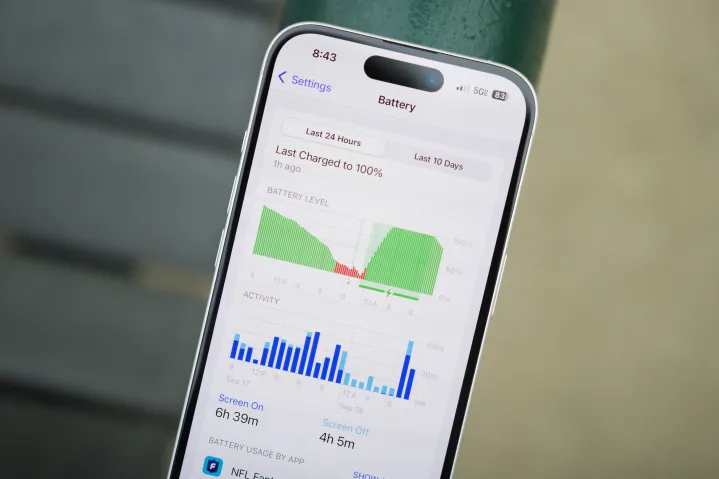Apple’s latest and greatest is here with the Apple iPhone 16. It comes packed with a new camera design, a more powerful A18 chip, an Action button, a Camera Control button, and more. It’s Apple’s best basic iPhone ever, and probably where you should start your research if you’re looking to buy a new Apple iPhone.
But like a lot of us, you may still be using a much older phone. Is the newest iPhone really that much better than your iPhone 13? Should you upgrade to the iPhone 16 if you’re still rocking an older iPhone? Let’s find out.
Apple iPhone 16 vs. iPhone 13: specs
| iPhone 16 | iPhone 13 | |
| Dimensions | 147.6 x 71.6 x 7.80 mm
5.81 x 2.82 x 0.31 inches |
146.7 x 71.5 x 7.65 mm
5.78 x 2.82 x 0.30 inches |
| Weight | 170 grams
6.0 ounces |
174 grams
6.14 ounces |
| Display | 6.1 inch Super Retina XDR OLED
2556 x 1179 resolution at 460 ppi 1000 nits typical brightness 1600 nits HDR brightness 2000 nits peak brightness (outdoor) 1 nit minimum brightness |
6.1 inch Super Retina XDR OLED
2532 x 1170 resolution at 460 ppi 800 nits typical brightness 1200 nits HDR brightness |
| Colors | Black
White Ultramarine Teal Pink |
Starlight
Midnight Blue Pink Red Green |
| Dynamic Island | Yes | No |
| Action button | Yes | No |
| Camera Control | Yes | No |
| Processor | A18 | A16 |
| Storage | 128GB
256GB 512GB |
128GB
256GB 512GB |
| Port | USB-C | Lightning |
| Initial iOS version | iOS 18 (2024) | iOS 15 (2021) |
| Software support | At least 5 years | At least five years (from launch) |
| Apple Intelligence | Yes | No |
| Rear camera | 48MP Fusion camera with f/1.6 aperture
12MP ultrawide camera with f/2.2 aperture .5x, 1x, 2x optical zoom options |
12MP main camera with f/1.6 aperture
12MP ultrawide camera with f/2.4 aperture .5x, 1x optical zoom options |
| Front camera | 12MP with f/1.9 aperture | 12MP with f/2.2 aperture |
| Macro photography | Yes | No |
| Spatial photos | Yes | No |
| Battery | 3561mAh | 3240mAh |
| Charging | 0-50% in 30 minutes (wired)
25W wireless (MagSafe) 15W wireless (Qi2) 4.5W reverse wireless |
0-50% in 30 minutes (wired)
15W wireless (MagSafe) 15W wireless (Qi2) |
| Price | From $799 | Available at select retailers |
| Review | iPhone 16 review | iPhone 13 review |
Apple iPhone 16 vs. iPhone 13: design

Despite the fact that Apple has been using a flat-edged frame since the iPhone 12, and that both of these phones have dual camera systems, the iPhone 13 and iPhone 16 couldn’t be more different.
The iPhone 16 has an Action button that replaces the old silent/ring switch, as well as the new Camera Control button on the bottom right of the frame. Even the display is different, with the newer iPhone having the Dynamic Island instead of a notch. Put the phones side by side, and it’s clear how far Apple has come in recent years.
Even the dual camera system is different. While the iPhone 13 has a square module with diagonally arranged lenses, the iPhone 16 has them in a vertical pill-shaped layout, with the LED flash centered adjacent to it. It harks back to the iPhone XS and iPhone 12 days, and is a nice change.

The iPhone 13 also has a Lightning port at the bottom to charge, while the iPhone 16 utilizes USB-C. We’ll get to that later in the battery life and charging section, but it’s an important change that arrived with the iPhone 15.
Finally, let’s talk about colors. Apple really outdid itself this year with the iPhone 16 color lineup, which are the most saturated colors that it’s come out with in a long time. The iPhone 16 comes in standard black and white, but there’s also a beautiful pink, teal, and Ultramarine (blue).
The iPhone 13 had some pretty good color options too: Starlight, Midnight, blue, pink, red, and green. But if you really like pink, then the iPhone 16 is the way to go.
Apple iPhone 16 vs. iPhone 13: display and performance

As different as the design is, the displays are a bit more similar. Both the iPhone 13 and iPhone 16 have 6.1-inch Super Retina XDR OLED displays, a 60Hz refresh rate, and a pixels per inch (ppi) density of 460.
However, the resolution on the iPhone 16 is a bit higher at 2556 x 1179 instead of 2532 x 1170, thanks to the fact that it has the Dynamic Island instead of the notch. Since the Dynamic Island is part of the display and not a blank space, that means a slight increase in pixel count.
Another big difference is the brightness that the displays can achieve. The iPhone 13 only has 800 nits typical brightness and 1200 nits for HDR content. Meanwhile, the iPhone 16 gets 1000 nits typically, with 1600 nits for HDR content and 2000 nits peak brightness outdoors. And when in dark rooms, the iPhone 16 can go all the way down to 1 nit minimum, which is easier on the eyes.

Performance-wise, the iPhone 16 is also a big step up. The iPhone 13 only has an A15 Bionic chip inside, while the iPhone 16 has the new A18 chip. During the keynote, Apple said that the A18 in the iPhone 16 is 30% faster than its predecessor, which was the iPhone 15’s A16, so it would be significantly faster and better-performing than the A15 in the iPhone 13.
Also, it’s important to note that between the iPhone 13 and iPhone 16, only the iPhone 16 will have enough power for the Apple Intelligence features coming in iOS 18.1 later in October. So even if you don’t upgrade from the iPhone 13, you still won’t be able to get a big core experience of iOS 18.
It’s not at all surprising, but the iPhone 16 has a serious edge here.
Apple iPhone 16 vs. iPhone 13: cameras

The base model iPhones have had a dual camera setup for several years now, and that applies to both the iPhone 13 and iPhone 16. With the iPhone 16, Apple went back to a vertical camera layout on the rear, rather than the diagonal setup we’ve had for a few years. But that’s not the only difference.

The iPhone 13 has a 12-megapixel main camera and a 12MP ultrawide lens, along with a 12MP selfie camera. On the iPhone 16, however, you have a 48MP Fusion camera, 12MP ultrawide camera, and up to 2x optical zoom options. The selfie camera is still 12MP, but you get more features with the iPhone 16 cameras, like Smart HDR 5, next-generation Portraits, new Photographic Styles, macro photography, and Spatial photos and video for Apple Vision Pro.
Basically, if you want a much better camera and video-recording capabilities, then the iPhone 16 is the clear winner.
Apple iPhone 16 vs. iPhone 13: software and updates

Currently, both the iPhone 13 and iPhone 16 run iOS 18. However, as we mentioned earlier, the iPhone 13 won’t be able to run Apple Intelligence features (they’re coming in iOS 18.1 later in October) as it lacks the required processing power to do so. But other non-AI features, like RCS messaging, new customization options, revamped Control Center, and more, are available. It’s only the features that utilize Apple Intelligence that will not be able to run on the iPhone 13, such as Writing Tools, Image Playground, Clean Up in Photos, and more.

The iPhone 16, however, is built from the ground up for Apple Intelligence. It ships with iOS 18 out of the box, though it won’t have Apple Intelligence until iOS 18.1 rolls out. But it will have all of the features of iOS 18, including Apple Intelligence, and should be able to handle everything you need to do with ease thanks to the A18 chip.
Though Apple has never given a specific number for software support like Samsung and Google (both offer seven years), Apple products typically last for around five years or more. For the iPhone 13, which originally came out in 2021, it should be supported for another two years or so. The iPhone 16 has a lot more longevity since it was just released, and should last until at least 2029.
Apple iPhone 16 vs. iPhone 13: battery life and charging

While there are a few differences between the iPhone 13 and iPhone 16 battery life and charging, both phones will only last around a single day.
Apple never states specifics online, but the iPhone 13 has a 3,240mAh battery inside and uses Lightning for fast charging up to 27 watts, which gets you to about 50% in 30 minutes. Wireless charging caps out at 15W for both MagSafe and Qi2-compatible chargers.
For the iPhone 16, Apple made the battery a bit bigger at 3,561mAh, so you can squeeze a bit more life out of it to get through the day. Apple also switched to USB-C beginning with the iPhone 15 series, so the iPhone 16 continues that. The wired charging speed remains the same at 27W, but MagSafe charging is now 25W and wireless Qi2 charging is 15W. The iPhone 16 also has reverse wireless charging at 4.5W, which is not available on the iPhone 13.
Apple iPhone 16 vs. iPhone 13: verdict

As you can see, if you are coming from an iPhone 13, the iPhone 16 can be quite a big upgrade. After all, a lot of people upgrade after around two or three years, which is typically the sweet spot, and the iPhone 13 came out three years ago.
The iPhone 16 makes it a good time to upgrade. You not only have a wide range of great colors to choose from, but you also get a big camera upgrade, the Action button, Dynamic Island, Camera Control, the A18 chip for iOS 18 and Apple Intelligence, and support for at least the next five years.
The iPhone 16 has gotten a lot of the features that were only on the Pro models before (Dynamic Island and Action button), so it’s a great way to catch up after three years.




